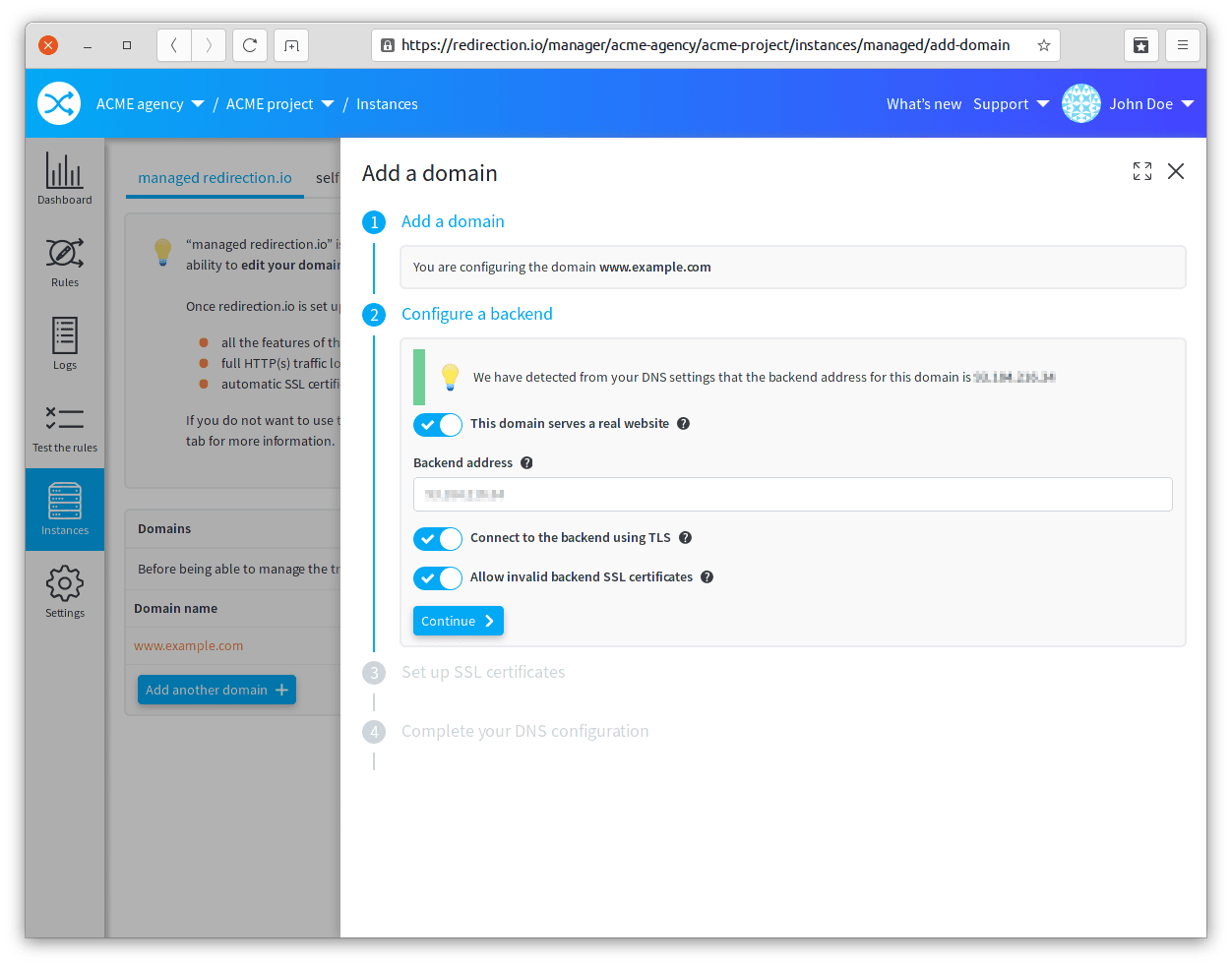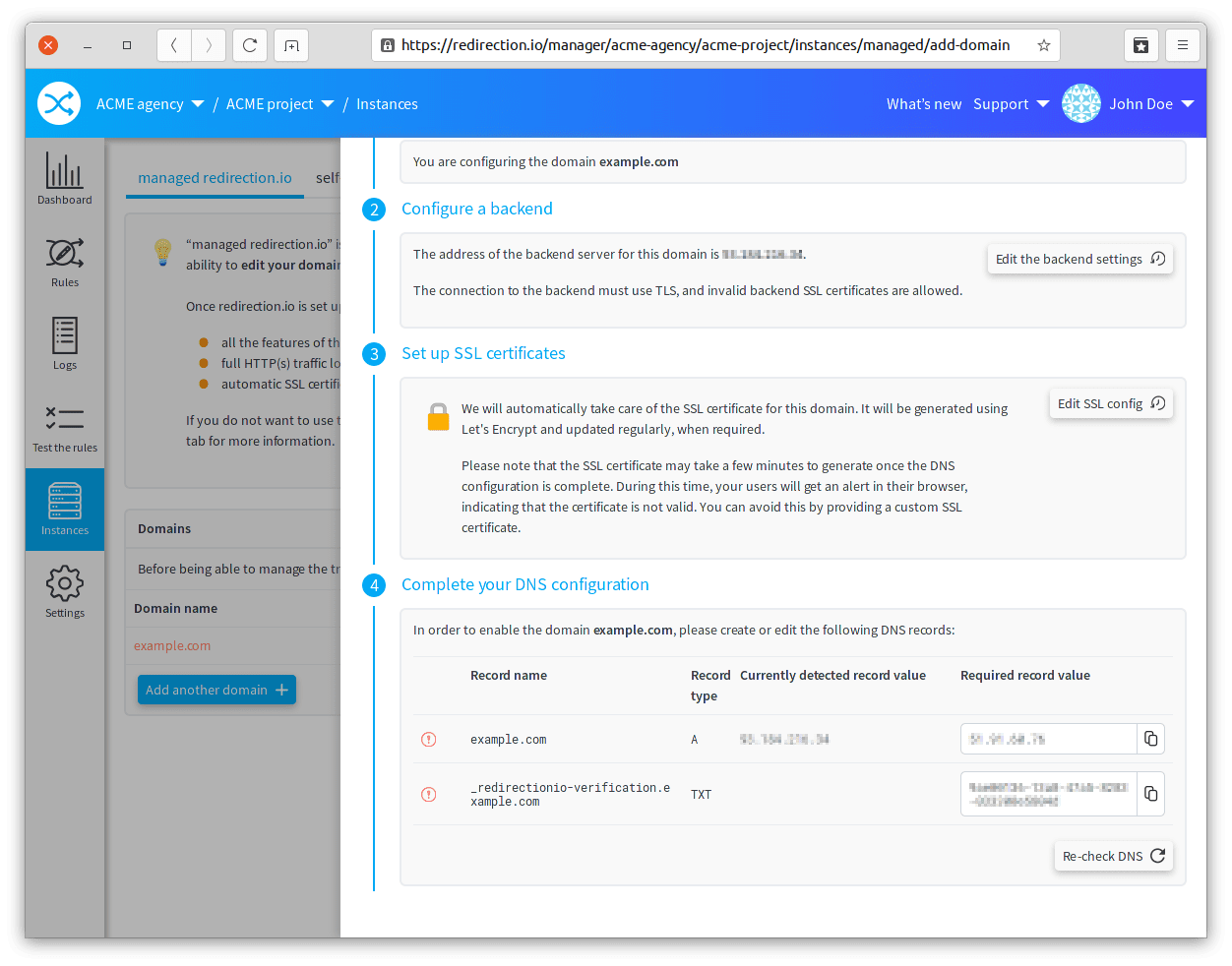The instructions below have been customized for your project "".
Customize these instructions for the project
Frequently asked questions
This page lists several frequently asked questions related to the managed redirection.io offer.
How long does it take to configure a managed instance in front of my existing website?
Configuring a redirection.io managed instance that proxifies traffic to an existing website involves several steps that only take a few minutes:
- create a redirection.io project
- upgrade to a paid plan (there's a 2-weeks free trial) in order to be allowed to proxify traffic of your website
- go the the manager's "instances" screen
- click on "Add another domain"


TXTverification record, then change theAorCNAMErecord)- click on "Re-check DNS"
Once we have ensured that the DNS records have been configured correctly, our infrastructure:
- starts up a node dedicated to your project in our various datacenters;
- then, uses Let's Encrypt services to generate a valid SSL certificate
These steps generally takes between 1 to 2 minutes, during which time your website will not be accessible. Once the SSL certificate is available, your website will be accessible again and you will be able to use all the features of redirection.io.
The documentation page "Add a domain to your project" gives detailed instructions on all the steps involved. We advise you to read it before starting the domain migration.
My managed instance does not work, what happens?
On the managed instances screen, you can see the status of the various instances. If redirection.io has detected a problem with an instance, it will appear in red or orange, depending on the seriousness of the problem:

There are several reasons why it may not be working properly:
DNS are not correctly configured for this instance
This is the main reason why your instance might not work properly. redirection.io needs several DNS entries to be correctly configured:
- an
AorCNAMEentry, so that requests for your (sub)domain are routed to the redirection.io infrastructure - a
TXTentry, to validate the ownership of the domain name and associate it with your project.
If the redirection.io interface shows an error in the DNS of your managed instance, here are some checks you can make:
- the
TXTentry has been configured on the_redirectionio-verificationsub-domain of the (sub)domain you are trying to install. For example, if you want to create a managed instance withwww.example.comas the address, you need to create a TXT record at_redirectionio-verification.www.example.com. If the TXT record contains an incorrect value, or if it is set to a different sub-domain, the validation will not pass and your managed instance will not start. - multiple
AorCNAMEentries: be careful not to set multiple values forAorCNAMEentries, otherwise your domain may only work partially - the DNS configuration has not been made on the correct DNS servers: in the instance configuration details panel, we remind you what the address of your DNS server is - it may be different from the registrar of your domain name, or there may be several DNS servers in use. Make sure you set the correct DNS server.
The backend address is not accessible
If a backend is configured in your managed instance, it must be accessible from the proxification IP addresses used by redirection.io. If your backend is restricted by IP address and cannot be accessed by redirection.io, an error page will be displayed to the user.
The managed instance is configured correctly, but the SSL certificate is not generated
Once your managed instance is properly configured, SSL certificates are usually generated in a few minutes. Occasionally, there may be some latency, but if it takes longer than ten minutes or so, please let us know.
If one of the parameters is not correctly configured, the managed instances interface will give you a clear warning. Changes to your domain name are detected in a matter of seconds or minutes, so there's no need to wait hours if the managed instances interface shows an error.
Is there a downtime when installing a redirection.io managed instance on my website?
Apart from the few of minutes mentionned above, no, there should be no downtime. Once redirection.io is installed, you can configure managed instances notifications in your project settings to be notified everytime an event occurs on your managed instance (certificate renewal, incorrect DNS settings, etc.).
Which are the managed instances proxification IP addresses used by redirection.io?
In our managed redirection offer, the redirection.io CDN acts as a reverse proxy infront of your infrastructure. In particular, this means that your backend server, which serves the content for your website, will see all incoming requests arrive from the redirection.io proxification nodes.
There is no specific affinity between a domain name and an ougoing IP address, which means that the requests your infrastructure will receive from us can come from several different IP addresses, depending on the location of the datacenter, the outgoing node that has been used, etc.
In certain cases, you may need to access the real user's IP address (access logging, etc.). The real user IP address is available using the X-Forwarded-For HTTP header, that our proxification infrastructure adds to the requests that are proxified to your backend servers.
It is bad practice to place blind trust in the value of this header, as it could be forged to mislead your platform and make you believe that the initial request comes from an IP different from its real origin.
This is why most Web servers or frameworks implement the notion of "Trusted Proxies", which allows you to whitelist a certain number of proxy server IP addresses, which will be the only ones for which your site will use the value possibly provided in the "X-Forwared-For" request header.
This mechanism is described in detail in the Mozilla Developer Network documentation.
We do not provide a fixed list of our managed instances outgoing IP addresses, as those may change on a regular basis. However, we provide a public API endpoint that lists the currently IP addresses used by our platform.
This list is available at the address https://api.redirection.io/ips
Check the detailed documentation for this endpoint.
What happens if the traffic of my website goes above the 100 GB monthly limit?
In order to provide a good service to all our customers, we have a fair use policy. If your website exceeds the 100 GB monthly limit, we will contact you to discuss the best solution for your website. We will never suspend your website without contacting you first.
When contacting you, we will provide you with information about your website's traffic in the form of an hourly spreadsheet for the last 30 days and a traffic diagram, which will help us determine your website's average traffic and the cause of the traffic spike.
If we conclude that the average traffic will remain above the allowed limits, we will suggest that you move up a level by buying more traffic.
Our Managed Instances Limits and Quota documentation gives details about our pricing for additonnal traffic volumes.
I have been warned that the IP address provided by the redirection.io managed instances is listed in a mail server blacklist
Some customers have reported that the IP address provided by the redirection.io managed instances is listed in a RBL, a mail server blacklist. This can cause worries about the deliverability of emails sent from the same IP address.
However, please note that the IP address provided by the redirection.io managed instances is not used to send emails. This part of our infrastructure is simply unable to deliver emails. The IP address is only used to serve HTTP requests, and it is not involved in any email-related activity. Some RBLs list IP address ranges or even entire autonomous systems, which can lead to false positives. Also, some RBLs are known to list large IP address ranges on a doubtful basis, including those used by cloud providers, and require a payment for unlisting.
In other words, the IP address provided by the redirection.io managed instances is physically not able to send emails, and it is not involved in any email-related activity. Therefore, it should not affect the deliverability of emails sent from your domain, even if it is falsely listed in an RBL.
If one of your recipients reports that your emails are being blocked due to the IP address provided by the redirection.io managed instances, you can explain that this IP address is not used for email delivery and should not be the cause of the issue. If the recipient's mail server is blocking emails based on the IP address provided by the redirection.io managed instances, you can ask them to review the RBLs they are using and consider whitelisting your domain or email address.
When adding a domain to redirection.io, we perform several checks to your DNS settings to help maximize your emails deliverability. For example, we will advise you to correctly configure the SPF DNS record for your domain.